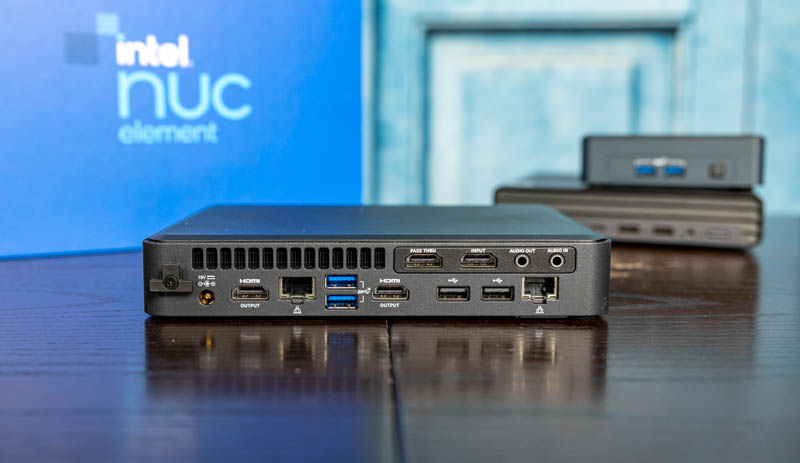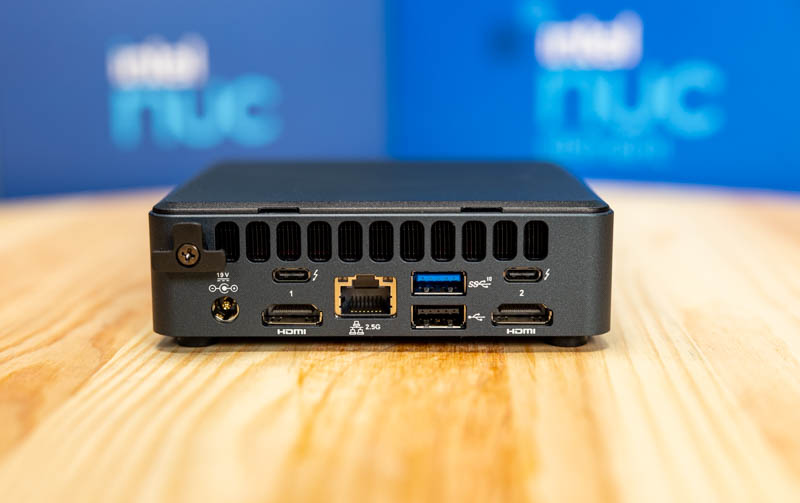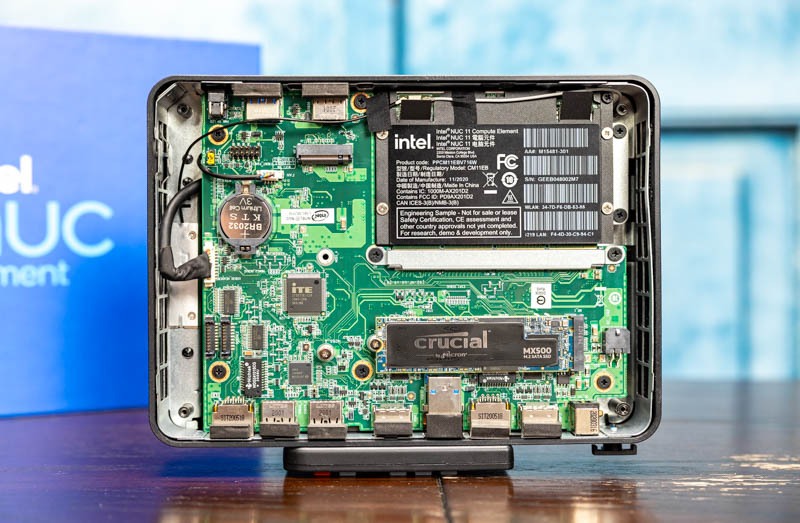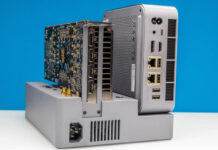Intel NUC NUC 11 Compute Element Power Consumption and Noise
In terms of power consumption, we saw some fairly solid figures. Here are the basics:
- Idle: 10W-11W
- 70% load: 40W
- 100% load: 48W
- Max observed: 53W
Overall, the noise was a bit less than with the NUC 11 Pro likely due to the larger chassis. We also have a smaller power 90W power adapter since the USB connectivity is less than the NUC 11 Pro which needs a larger power supply to drive potential USB devices.
Key Lessons Learned
We could not find pricing for this unit, but the chassis without the CPU, memory, and WiFi module is usually just over $250. One still needs to add the compute element plus a SSD to make this a functional unit. Our sense, based on previous-gen pricing, is that this will be well over $700. Also, that does not include the Windows 10 Pro license. So it seems roughly in line with higher-end Project TinyMiniMicro nodes such as the Lenovo ThinkCentre M75q Gen2 Tiny and some of the Core i9-10900T units we have purchased.

If a 2.5GbE network and Thunderbolt/ USB are major features one wants, then the Intel NUC 11 Pro is very attractive. Given how close the CPU performance was, it was a very close call between the two options. The NUC 11 Pro has 2.5GbE in a single port, but the Compute Element has dual 1GbE. The Compute Element has the AV HDMI capture, but a higher-speed USB/ Thunderbolt opens more options.

While the NUC 11 Compute Element is a very nice package and certainly offers something for those who are looking for a 1080p HDMI capture solution built-in.

Going beyond what we see in this packaging, Intel also has a version of its chassis that is designed for more IoT/ embedded. Perhaps the bigger idea is that the Compute Element card can be used with systems designed with partners that are willing to give up control of the DRAM/ WiFi customization to be able to use the lower-TDP soldered parts without having to design an entire motherboard with it. The one item this has over a TinyMiniMicro offering is that it can use the non-socketed CPUs so for a small vendor that does not have the volume to make a platform with a specific CPU/ memory SKU, perhaps this makes more sense than what we are seeing packaged here.
Final Words
This is one of those strange cases at STH. Had we not delivered a series over the past few quarters with dozens of reviews of ~1L PCs spanning the DDR4 generations from multiple vendors in Project TinyMiniMicro, this Intel NUC 11 Compute Element solution would have seemed like the most amazing unit on the market. After having done the exercise, we think it is still good, but not necessarily the most fiscally prudent solution unless one needs the exact configuration/ feature combination that this offers.

Intel could, as part of its Compute Element program, build a different motherboard/ chassis than Fort Beach and really take this platform to the next level. Adding Thunderbolt along with swapping the NIC(s) out for the Intel i225 would be a game-changer, as would upgrading most of the USB to Gen3. Perhaps that is the point of the Compute Element program that there is the flexibility to make those changes.




So this next unit of computing – an atom, if you will – is, in fact, composed of a limited number of smaller, exotic particles which are expensive to obtain, can’t be easily reused, and are likely to decay in value quickly? Sounds familiar…
I got NUC8/10/11 each with the “near top” i7 variants and top iGPUs available (48/24/96 EUs respectively). To me it boiled down to the NUC8/10 being next to identical on single-thread performance and the NUC10/11 being next to identical on multi-thread performance (but 6 vs 4 cores to get there).
I am very surprised to see that the highest bin of the Tiger Lake i7 with LDDR4 doesn’t show any difference to the i5 with ordinary DDR4: could you run a synthetic RAM bandwidth benchmark on both?
I guess most of your benchmarks are simply too lengthy for the i7 to show off its sprinting ability, but have it run against the TDP limits, which may not be so different for the distinct bins.
OpenSSL and ZIP may just fully fit into the smaller i5 cache, while a kernel compile may be mostly dirty (source code) data and cached (compiler) code, with all FP sections of the CPU snoozing and mostly the jump prediction and load/store units doing overtime. I’d hazard that compiles are pretty much (RAM) I/O bound after they’ve consumed the logic/integer parts of a modern CPU these days.
@GreenReaper: You’re right, but most likely so is Intel in this case. NUC fit in to niches pretty much by definition and here they have identified a niche outside the datacenter and big enough to fit a million or a couple, where they can both get more than the CPU slice of the pie and outscale a couple of OEMs for a product that is likely to see high mass surveillance demand.
The real issue with these compute elements is that Intel introduces them, then the so called standard dies in a generation or two.
Hello, I was wondering if the case comes with pre-drilled VESA holes, or a VESA mount.
Thank you.
The intel spec for the 11 series nuc compute element says it has thunderbolt, however can not find case that will allow this feature to be utilised,